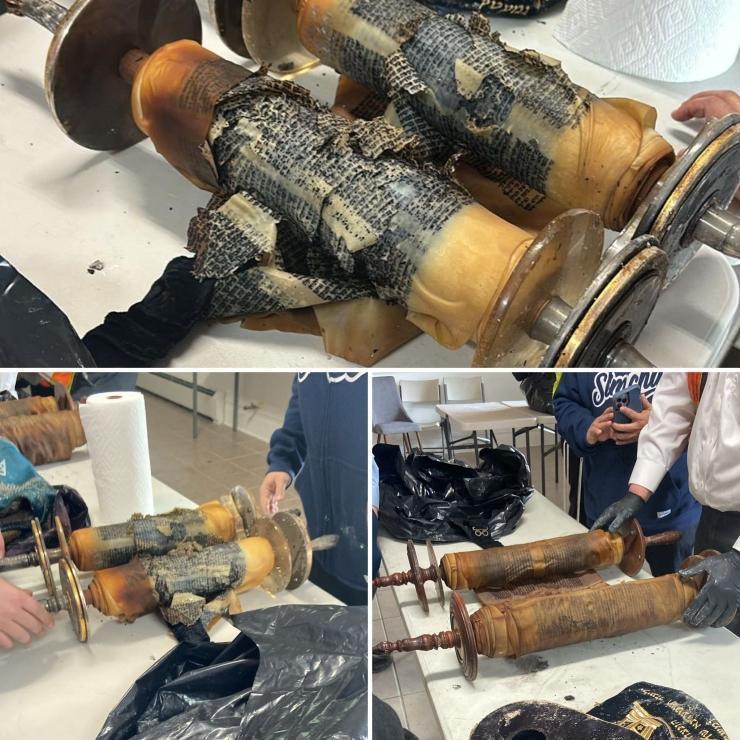Today Marks Rabbi Dr. Naftali Berg’s Yartzeit
Today, the 27th of Tammuz, marks the Yartzeit of Rabbi Dr. Naftali Berg, oB”M, who was a gifted and world-renowned scientist for the United States Defense Department. His work as a scientist seamlessly meshed with his inner world – that of a Chossid of the Rebbe. In connection with the Yartzeit we are publicizing an article written a few years ago • Full Article
Today, the 27th of Tammuz, marks the Yartzeit of Rabbi Dr. Naftali Berg, oB”M, who was a gifted and world-renowned scientist for the United States Defense Department. His work as a scientist seamlessly meshed with his inner world – that of a Chossid of the Rebbe. In connection with the Yartzeit we are publicizing an article written a few years ago.
***
Beis Moshiach/By Prof. Shimon Silman, RYAL Institute and Touro College
In his famous lecture on “Swords into Plowshares at the Pentagon” at the Moshiach and Science conference of the Rabbi Yisroel Aryeh Leib Institute in 5753 (1993), Rabbi Dr. Naftali Berg (whose yahrtzait was last week, 27 Tammuz) spoke about the new program of dual use technology initiated that year as a Swords into Plowshares process. In his words, “The main point is that we really see the revelation of Moshiach now that the administration is taking half a billion dollars per year and putting it into these ‘dual use technologies.’ It is certainly a fulfillment of the Rebbe MH”M’s sicha of a year ago [5752] that ‘v’chitzu charvosom l’itim’—‘they shall beat their swords into plowshares’—that the nations of the earth will take their military budgets and convert them into food production and other peacetime uses.”
Whatever happened with this program? Was it successful and what came out of it? In this article we will discuss the dual use program in the USA described by Dr. Berg in his lecture.
Generally speaking, “dual use technology” refers to any military technology that has civilian applications. But what we are focusing on here is specifically the role played by dual use technology in the U.S. following the Swords into Plowshares (SIP) declaration.
First some background: In 1992, following the SIP declaration, Congress passed the Defense Conversion, Reinvestment, and Transition Assistance Act initiating the Technology Reinvestment Project (TRP). The ideal behind this project was to “ease the post-Cold War conversion of the defense industrial base to commercial production” or Swords into Plowshares.
Actually, the US had been running dual use programs since the 1980s, such as the Very High Speed Integrated Circuits (VHSIC) project and the Strategic Computing Program (SCP). But these programs were designed primarily for military purposes. The concept was that the military could take advantage of technological innovations in the commercial sector so that military technology would advance faster than if each sector carried out its own research independently.
The innovation of the TRP was that it aimed for a perfect balance, favoring neither the military nor the commercial, but instead looking to develop technologies that would be useful both for military and civilian use—“to advance the general technological state of the art.” The same technology could be used in different products that would meet both military and civilian needs.
TRP began to be implemented by the Clinton administration in early 1993 with a budget of $927 million for the first year. Competitions for TRP grants were conducted by the Defense Technology Coordinating Council, made up of non-military people from the National Science Foundation, the Departments of Energy and Transportation, the National Aeronautics and Space Administration (NASA), and the Commerce Department’s National Institute of Standards and Technology (NIST). The diversity of the council’s membership was meant to enhance the program’s technical expertise and to ensure that TRP managers were aware of recent technological developments in commercial markets and civilian federal agencies.
But the management and control of the program was assigned to the Pentagon’s Advanced Research Projects Agency (ARPA). This created a fundamental political imperative: TRP projects had to be justified primarily on the basis of their anticipated value for national defense.
[ARPA was created as an agency of the Department of Defense to carry out military research in 1958 following Russia’s launch of the Sputnik satellites. The agency’s name was changed back and forth from ARPA to DARPA (Defense Advanced Research Projects Agency) a few times. It is currently called DARPA.]
From the very beginning the TRP was plagued by the demands of various political factions with conflicting goals. Contrast this with the establishment of the ISTC in Russia where there was one goal: to convert Russian military technology to peaceful purposes and to provide employment for high level Russian scientists and engineers so they would not be tempted by offers of employment by other (third-world) countries to develop military technology programs for them. Dual use technology was out of the question there since none of the international partners in the project (US, EU and Japan) would be interested in supporting further development of Russian military technology.
The Clinton administration itself promoted TRP as the centerpiece of the nation’s defense conversion effort—Swords into Plowshares—and reinforced this impression in speeches and public documents describing the program. In a White House press release dated April 12, 1993, President Clinton called TRP “a key component of my conversion plan . . . [that] will play a vital role in helping defense companies adjust and compete.”
ON-THE-JOB SWORDS INTO PLOWSHARES
One of the projects TRP has funded was the development of a turbo alternator for electric hybrid vehicles. The turbo alternator would serve a military need for tank engines that are harder to detect with infrared sensors, because the hybrid engines emit less heat. It simultaneously serves a clear commercial need for small, energy efficient, low-emission engines that can be used in hybrid (diesel/electric) city buses.
In some cases the dual use approach worked very well for both soldiers and civilians. For example, one TRP project was designed to train military surgeons to do certain surgical procedures. It started with technology already developed for civilian use and was upgraded to train military surgeons to treat battlefield injuries. Then the software and hardware was adapted for use in civilian medical training in areas such as disaster response and emergency room medicine, with the goal of developing minimally invasive surgical techniques. We consider this example a pure Swords into Plowshares development because even the “military” use—treating wounded soldiers—can hardly be considered a military purpose.
TRP’s most important long-term goal was to promote commercial-military integration—the creation of a single unified industrial base for commercial and military technology development. Most TRP officials believed that this would be more successful than direct defense conversion.
They argued that even if traditional defense contractors converted to new civilian products, they would be unlikely to compete successfully in commercial markets, given their high-overhead operations. Instead, they stressed the need to help specialized defense companies find commercial partners to teach them what they need to learn about marketing and high-quality, low-cost manufacturing and thus overcome the barriers that separate the defense industrial base from the rest of the economy. In other words, the commercial would partner with the military. In the process, the civilian would teach the military how to produce efficient, low cost civilian products. It was sort of an on-the-job training for the military on how to convert to civilian use—an on-the-job Swords into Plowshares.
Many TRP projects also boosted or accelerated the efforts of commercial organizations that were already under way. For example, TRP awarded grants to California’s CALSTART electric vehicle consortium, originally funded by the state government as well as corporate funders, including Lockheed, Allied Signal, and Hughes.
In addition, several teams that were created specifically to apply for TRP grants but did not win any TRP money in the first round of competition recognized the potential leverage that they had acquired as a group and decided to stick together and competed successfully for TRP funds in the second and third rounds. By encouraging this kind of teamwork, TRP also contributed to the cause of defense conversion. It sponsored technology development projects that sought new civilian uses for military technology, as well as technology deployment projects that attempted to modernize engineering education and promote the diffusion of best-practice manufacturing throughout the economy.
Other examples of TRP projects included developing rechargeable lithium ion batteries (which would be widely deployed on the battlefield as well as in cell phones and laptop computers), developing uncooled infrared sensors (for military, police and firefighter night vision systems) and developing low-cost manufacturing processes for advanced display technologies. Many other TRP projects contributed toward energy efficiency, improved public health, environmental protection, and pollution prevention.
POLITICAL PRESSURE
Because the TRP program received all of its money and most of its technical expertise from the Pentagon, the panels that awarded the TRP grants were compelled to justify the projects primarily in terms of their military value. Also, the awards made had to be justified to Congress in terms of their value for national defense since the money was coming from the defense budget.
The Clinton administration never successfully cemented a political coalition in support of TRP that could counter these pressures from the defense establishment. Also, the program was not very successful in replacing lost defense jobs, which caused it to lose support among labor groups. TRP was discontinued at the end of fiscal 1996 and replaced with a similar dual-use technology development program more clearly designed to fulfill military needs.
Dual use is a delicate balance between military and civilian use, and in this case the military won. But the United States, which—whether it likes it or not—still has the role of “the world’s policeman,” must maintain a high military capability. Despite its reduced threat perception following the end of the cold war, it cannot, it seems to me, implement an absolute military to civilian conversion—not until we enter the next phase of Swords into Plowshares, when “Nation shall not raise a sword against nation; nor shall they learn any more war.”
1087
Join ChabadInfo's News Roundup and alerts for the HOTTEST Chabad news and updates!










































